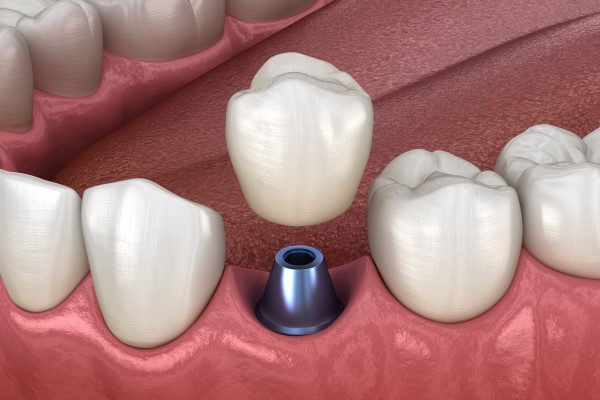What Materials Are Used in an Implant Crown?

An implant crown serves as a replacement for your lost tooth when you opt to replace it with an implant. The implant replaces the missing teeth roots, helping to prevent bone tissue loss due to lost teeth. Implants can be fitted with crowns or other restorations like dentures or bridges to replace missing teeth.
The process of installing an implant can take up to six months since the implant needs time to fuse with bone tissues around it. Placing an implant crown on it is typically the last step.
The different materials an implant crown can be made with
Getting a dental implant is not complete until a crown or some other restoration has been attached to the implant to replace missing teeth. Factors that should be considered when trying to figure out what type of implant crown works for a patient include the type of bite forces that will be placed on the restoration, allergies the patient has, and how much room the patient has in their mouth for the restoration.
Depending on the type of implant placed in the patient’s jaw, they might also have to select an abutment that is used to attach the crown to the implant. Abutments are typically made out of materials like zirconia, titanium, or metal alloys.
Titanium abutments are typically preferred given how durable the metal is. Abutments made from titanium are better suited for teeth at the back of the mouth, while zirconia abutments work well for front teeth since they have a natural white color.
Dentists and their patients also have to determine if they want to go with a screw-retained or cemented crown. Screw-retained crowns are easier to remove, making it easier to make repairs and perform maintenance on them. Cement retained crowns are tricker to remove once installed, but they are less likely to become loose while being used.
Some of the popular materials implant crowns can be made from include:
1. Porcelain fused to metal crowns
These restorations are known to be durable while providing great aesthetics. The top part of the restoration is made with porcelain, but its base is fused with metal, allowing it to handle high loads. These types of crown are typically recommended for teeth at the back of the mouth since the area where the metal and porcelain join sometimes leads to a visible line showing over time.
2. Gold crowns
These are the most durable implant crowns, but not everyone wants the aesthetics of having gold teeth. They are great for teeth in the back of the mouth since they can handle significant loads and are gentle on adjacent teeth.
3. E-max crowns
These crowns are made from lithium disilicate, and they can handle high loads. The can be used to replace teeth in the back or front of the mouth.
Explore dental implant crowns
Looking for the right type of crown for your implant? Call or visit our Forest Hills clinic to set up a consultation with our dentist.
Request an appointment here: https://metrosmiles.com or call Metro Smiles Dental at (718) 841-9591 for an appointment in our Forest Hills office.
Check out what others are saying about our services on Yelp: Implant Crown in Forest Hills, NY.
Related Posts
Whether you are missing a tooth or have a cracked tooth that needs repair, restorative dentistry can help. This article will discuss some of the most common dental restoration services available today.A tooth-colored filling, also known as composite resin, is made of plastic and can be used to replace decayed areas of teeth. The material…
Clear braces and other orthodontic advances make teeth straightening treatment more attractive to many patients. From clear aligners to ceramic braces, these innovative treatments allow patients to align their smiles without noticeable metal brackets and wires. Thanks to these alternatives, teeth straightening has become more accessible to those who want to avoid traditional metal braces.Traditional…
Cracked and chipped teeth can be unsightly and painful, but dental restoration can help. Even a painless chip or crack may become a bigger problem if left untreated. Severe pain, swollen and tender gums, and infection may result. In the worst cases, it will be necessary to extract the broken tooth. There are many ways…
You may need a type of dental restoration at some point in your life. There are many types of treatments available. Knowing how to select each one can give you the results that you need. Here are some tips on how to choose the right type of dental restoration procedure that will fit your dental…
